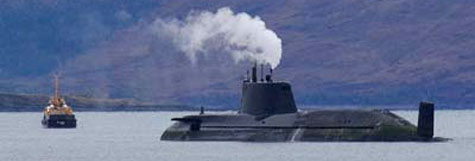
It had all the elements of bad farce. The HMS Astute is Britain’s newest, stealthiest and no doubt most expensive submarine. As described by the BBC, “Aside from attack capabilities, it is able to sit in waters off the coast undetected, delivering the UK’s special forces where needed or even listening to mobile phone conversations.” After running hard aground on a shingle bank near the Skye Bridge on the Isle of Skye, becoming the subject of YouTube videos and the front page of the New York Times web site as well as hundreds of other news outlets, stealthy was not the first word that came to mind. “Undetected,” she was definitely not.
A former nuclear submarine engineer, Martin Douglas, is quoted as saying “Propulsion and shape are very much a closely-guarded secret because it is incredibly effective and of a unique design.” Oopps. Perhaps not such a closely guarded secret anymore. “The channel that runs underneath the Skye Bridge has red and green buoys known as lateral markers to ensure vessels do not run aground. HMS Astute appeared to be lying in shallow water several hundred metres beyond that safe route.”
The sub was towed off the shingle and will be inspected for rudder damage and possible damage to any of the 39,000 acoustic panels which cover its hull. One of the tugs sent to rescue HMS Astute was the Maritime and Coastguard Agency-chartered Anglian Prince, one of the vessels set to be scrapped under the budget cutting announced last week. Few missed the irony.
As reported by the New York Times this was not the first time that a British submarine has had troubles in these waters.
Critics noted that another British submarine, H.M.S. Trafalgar, ran aground off Skye in 2002. At that time, an inquiry found that a crewman had placed opaque tracing paper over a navigation chart to protect it, leading to the submarine’s running onto well-charted rocks.
In the most costly mishap for the nuclear-powered submarine fleet, H.M.S. Superb, also a missile-carrying attack vessel, struck an underwater “pinnacle” in the Red Sea south of Suez, Egypt, in 2008, leading to a court-martial for the vessel’s commander, who failed to spot the obstruction on sea charts.
The Superb was decommissioned because of the prohibitive cost of repairs after it was towed back to Britain. Two other nuclear submarines, H.M.S. Triumph and H.M.S. Victoria, were involved in mishaps at sea in 2000.
Even before being put to sea for the first time a year ago, the Astute was a navy showpiece. The first submarine to be built from a British shipyard in 10 years, it was the subject of an extended BBC television documentary shown this summer that chronicled every stage of its construction. Partly because of its advanced design, and partly because of management problems, it was completed nearly four years late and with a cost overrun of more than $1 billion.
Thanks to Rick Rudofsky for passing along the BBC article.

Pingback: Aquarium Glory Blog
Pingback: Cmdr. Andrew Coles of HMS Astute Relieved of Command : Old Salt Blog – a virtual port of call for all those who love the sea